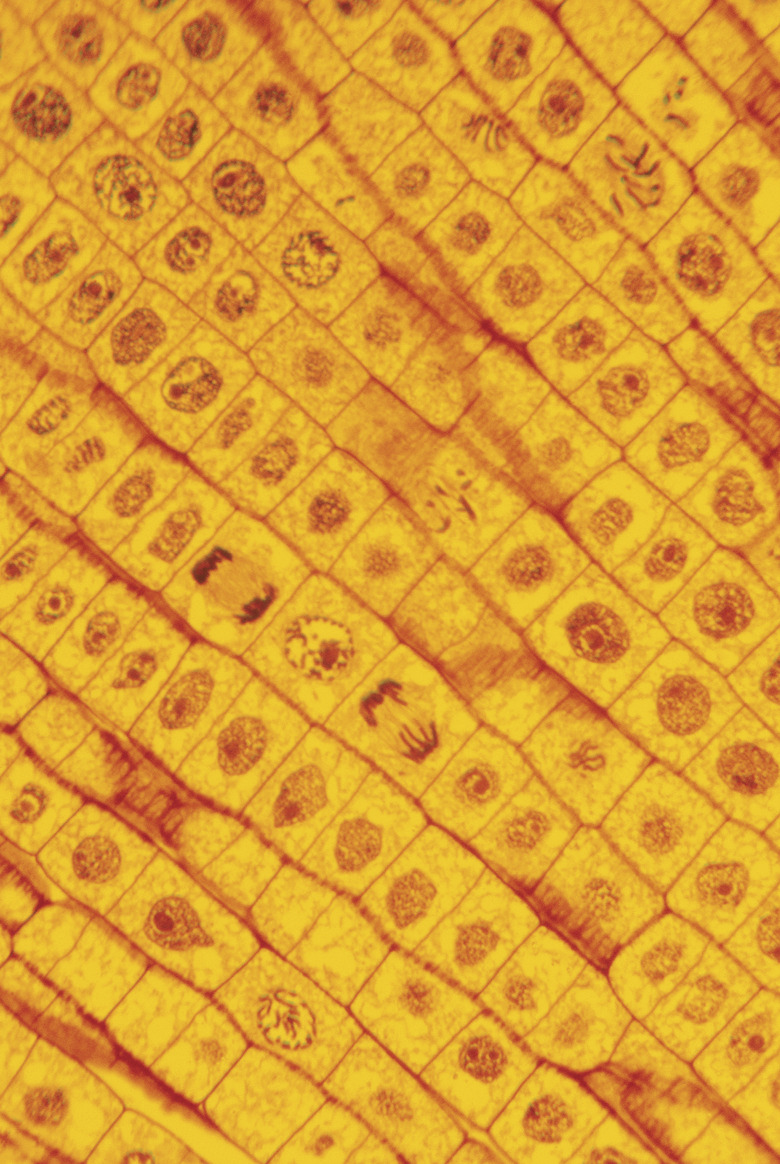A Description Of The Purpose Of Mitosis
Mitosis is the perpetual process of cell division that results in a single cell splitting into two cells, which are spitting images of each other. Between divisions, cells enter interphase and copy DNA in preparation for the next replication. The cell cycle repeats itself many times over. Without mitosis, babies wouldn't grow up, cuts wouldn't heal and broken bones wouldn't mend.
Read more about the steps and facts of mitosis.
Purpose of Cell Cycle: Growth
African elephants, blue whales and towering redwoods are among the many living organisms that grow to gigantic proportions from a single fertilized cell. You may wonder how such an impressive feat is possible. The embryonic cell continues to divide and differentiate into specialized somatic (non-reproductive) cells until full growth is reached. The cell cycle can take minutes to years to complete, depending on the type of cell and growth conditions.
Cells have the capacity to divide exponentially through the process of mitosis. Sometimes growth results from changes in the cell itself rather than through division. For instance, a steady diet of French fries may lead to fat cells enlarging, but not necessarily increasing in number.
Purpose of Cell Cycle: Repair
An essential purpose of mitosis is to replace dead or damaged cells like skin cells that are constantly being shed. Mitosis also gets to work when the body experiences a cut or a broken bone. Mitosis quickly replaces lost cells to restore normal functioning.
Typically, cells are not allowed to transmit DNA that has been altered by toxins, ultraviolet light or other carcinogens that could give rise to tumors. If repair is not possible, the cell receives a signal to die off. Mitosis reinvigorates injured tissue with normal cells.
Scientists at Arizona State University report that their work with green anole lizards is helping to advance the study of cell repair. Studies show that a lizard can regrow a tail lost to a predator through activation of 326 genes. Humans possess many of these same genes that could potentially stimulate the body to regenerate worn-out cartilage or repair spinal cord injury, for instance.
Stages of Cell Cycle
The purpose of the cell cycle is to create new cells to meet the ever changing needs of living organisms. The length of time needed to complete a full cell cycle depends on factors such as the cell's age, type and growing conditions. The complex process of mitosis is divided into stages that must go according to plan:
• Interphase: This is a period
of normal cell growth. Simultaneously, proteins are being synthesized,
organelles multiply and two identical sets of chromosomes form inside the nucleus.
• Prophase: Chromosomes
condense into pairs of matching X-shaped chromatids called sister chromatids. The
nuclear membrane dissolves to release genetic material during cell division.
The mitotic spindle gets into position; centrioles move to opposite poles. Many sources add an additional phase after this, called prometaphase.
• Metaphase: Chromosomes line
up along the center of the cell. Mitotic spindle fibers from the centrioles
firmly grip the sister chromatids at their centromere.
• Anaphase: The mitotic
spindle pulls apart the sister chromosomes and moves them to opposite poles
where a nucleus will form.
• Telophase: A nuclear membrane
encircles the chromosomes. Cytokinesis occurs when the cell membrane pinches in
the middle to make two separate daughter cells identical to the original parent
cell before it divided. In plants, the two cells are divided by a cell plate.
Cell Cycle Checkpoints
Cell division must be carefully choreographed from start to finish. Errors can have deadly consequences or give rise to visible mutations. Cell cycle phases are irreversible, so mistakes must be caught in time. Cell cycle checkpoints occur throughout the process of division:
• **G1 checkpoint:** Protein reserves and
DNA are assessed to determine if conditions are right for division.
• **G2 checkpoint:** Chromosomes must be in good
shape and completely duplicated, or the cycle halts until corrections are made.
• M checkpoint:** Sister chromatids in the mitotic stage must be securely attached
to spindles before centrioles pull the chromosomes to opposite poles. Other regulators such as certain intracellular
proteins and molecules also send signals when stages in a cell cycle should
stop or proceed.
Cite This Article
MLA
Dowd, Mary. "A Description Of The Purpose Of Mitosis" sciencing.com, https://www.sciencing.com/description-purpose-mitosis-9556/. 30 July 2019.
APA
Dowd, Mary. (2019, July 30). A Description Of The Purpose Of Mitosis. sciencing.com. Retrieved from https://www.sciencing.com/description-purpose-mitosis-9556/
Chicago
Dowd, Mary. A Description Of The Purpose Of Mitosis last modified March 24, 2022. https://www.sciencing.com/description-purpose-mitosis-9556/
